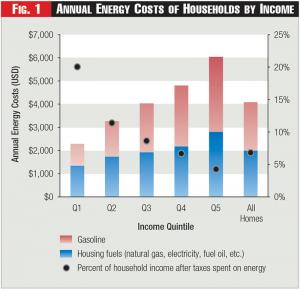Perspective from Cooperative Power
Keith Dennis is Senior Director for Strategic Initiatives at the National Rural Electric Cooperative Association. He previously worked at the U.S. Department of Energy and White House Council on Environmental Quality, and in the private sector as a third-party verifier of energy projects. At NRECA, he addresses key energy efficiency issues in industry forums and political arenas on behalf of NRECA’s nine hundred national electric co-op members and their forty-two million customers.
Consumers with low household incomes bear the heaviest burden of energy costs, yet are those who can least afford them.

Traditional energy efficiency programs remain an important and essential way to save consumers money while improving health and the environment. However, according to the Lawrence Berkeley National Lab, traditional conservation programs targeted to low-income households cost more, at 14.2 cents per kilowatt-hour, as opposed to an average of 4.6 cents per kilowatt-hour across all sectors.
This data begs the question: Is there a better way to reduce energy costs for low-income households while making progress towards environmental goals?
Research suggests the answer may lie with new, strategic uses of electricity, known as beneficial electrification.
There is an increasingly strong agreement that in order to meet aggressive greenhouse gas reduction goals, vast numbers of consumers will need to switch from directly using fossil fuels (like fuel oil, gasoline, diesel, propane and natural gas) to electricity, which can be a low greenhouse gas power resource thanks to renewable energy and nuclear energy.
 Figure 1 - Annual Energy Costs of Households by Income
Figure 1 - Annual Energy Costs of Households by Income
This trend can also benefit consumers by lowering costs, thanks to emerging realities such as low and negatively priced wholesale electricity, curtailed low-carbon energy resources, and an increased need for flexible end-use loads. Together, these trends offer an opportunity to provide savings to consumers and foster a more efficient electric grid.
Some adaptation will be needed to achieve this beneficial electrification for consumers at all income levels. Policymakers, advocates and other stakeholders must become comfortable with the concept that programs to help people manage energy costs should allow for consumers to use more electricity, not less, as long as they are reducing their total energy-related expenses and displacing direct use of fossil fuels.
Energy Costs by Income
While 2015 Census data shows that low-income consumers tend to use less energy than their higher-income counterparts, the percentage of their household income dedicated to energy is much higher.
See Figure One.
Consumers in the lowest income bracket spend more than twenty percent of household income to meet their energy needs. By comparison, consumers in the highest income bracket spend less than five percent on energy.
It is this high relative impact of energy cost on lower income consumers that at first glance would seem to make energy efficiency a good fit for them. Yet it is the lower overall energy use of this demographic that may make alternative options better for reducing energy-related expenses and improving quality of life for these folks.
Can Using More Electricity Save Money?
Reducing energy use in lower-income households makes sense unless there is a better option to achieve energy cost savings. It is worth following up on research that suggests these consumers may have more to gain from switching to using electricity at the end-use point when combined with new utility applications and programs.
Since lower income consumers on average use less energy, traditional conservation methods offer a smaller benefit. Consumers who use less energy to start with have less total energy that can be saved through efficiency measures. Moreover, the data suggests that achieving cost reductions through reducing energy use is relatively expensive.
In addition to the important work of increasing efficiency at the end-use point, we should look for opportunities to reduce energy costs by changing when electricity is used, and not focus solely on reducing the amount of electricity used.
Two conditions must be present for low-income consumers to benefit from demand-side management cost-savings: Consumers need to choose electric products (such as cars, appliances and other devices) over fossil-fuel burning options; and utilities must have robust programs in place to support beneficial electrification.
Utilities can and should educate advocates for low-income consumers and energy efficiency on the promotion of "beneficial electrification" - the use of electricity in place of end-uses that directly combust fossil fuels, such as water heaters and electric vehicles.
While this concept (saving money and reducing environmental impact while increasing the total amount of electricity used) is counterintuitive to long-time energy efficiency supporters, it is essential to achieving long-term economic and environmental goals.
Here are three ways utility-sponsored beneficial electrification programs can help consumers save money:
Helping Consumers with Up-Front Costs of Equipment: An essential element of beneficial electrification for lower-income consumers is helping them manage the up-front costs of expensive appliances such as water heaters, HVAC systems, and vehicles.
According to Forbes, sixty-three percent of Americans do not have enough savings to cover a five-hundred-dollar emergency. Given that a replacement water heater can cost well over that amount, programs that help cover up-front costs of necessary appliances can help consumers avert a financial emergency and free up money for use on other expenses that directly improve consumers' lives.
Rather than investing thousands of dollars to upgrade a house to save energy that will pay back over the course of years, utilities can harness the value in aggregating and controlling loads like water heaters, and pass the savings on to consumers to reduce or eliminate the up-front cost of the device.
This programmatic approach can offer immediate economic relief to consumers, lowering their overall energy-related expenses (even if their utility bills remain relatively unchanged) while helping improve the overall efficiency of the grid.
Electric cooperatives across the country feature programs that provide discounts on controlled electric water heaters, including lifetime replacement programs, leasing programs, free repair programs and more.
This is only one of many electric utility options to provide compensation to consumers who participate in distributed energy resource programs. These programs could be greatly expanded in the coming years to include other space heating and electric vehicle technology.
Encouraging Use of Off-Peak Rates: Imagine if you could go to a gas station in the middle of the night and purchase gasoline for only one-tenth of its daytime price. Better yet, imagine you didn't have to go anywhere, and this highly discounted refueling occurred right at your house. This is the opportunity provided by electric vehicle charging - a prime flexible electric load - and it represents a tremendous opportunity to re-think energy efficiency program design.
As a simple example, using super off-peak rates at Piedmont Electric Cooperative in North Carolina (2.7 cents every day from 10 p.m. to 5 a.m.), it would cost $129 per year to charge an electric vehicle to drive 13,500 miles per year instead of the nearly $1,200 per year it costs to refuel with gasoline for a similar model car traveling the same distance.
This approximate ninety percent annual reduction in refueling cost also would reduce carbon emissions, as electric vehicles create less carbon emissions than their combustion engine counterparts in all regions of the country today.
With gasoline-powered vehicles, consumers have no meaningful way to reduce fuel costs associated with driving to work or home, other than to make major changes in their vehicle or lifestyle. With electricity and off-peak rates, the power is in consumers' hands to reduce their energy bills.
Given current vehicle prices, it may seem a stretch to think of electric cars as a savings opportunity for low or moderate-income consumers. But in the long-term, these vehicles may not just be options for the wealthy.
Bloomberg predicts electric vehicles will cost the same as gasoline vehicles within the next decade. Add a lower price point to much lower fueling costs, lower maintenance costs, and discounts for participating in flexible load programs, and electric vehicles may provide a great option to save money overall.
A different way to think about this is to pretend that water heaters are as sexy as Teslas and apply the same logic of off-peak rates to water heaters to achieve energy savings. After all, everyone needs hot water.
Three-Part Rates: Heavy demand for electricity during just a few hours of the day can drive up costs for utilities. By implementing a three-part rate, consumers and utilities can benefit.
Mid-Carolina Electric Cooperative, a consumer-owned utility in South Carolina, implemented a rate change and their wholesale power supply bill dropped by more than three million dollars in 2016.
These savings were achieved through a monthly account adjustment, a dramatically lowered energy charge and a kilowatt charge triggered by the highest one hour of demand. The more electricity use that a consumer can shift away from peak hours, the more that consumer benefits from the lower energy charge.
The programs resulted in significant savings even though the total amount of electric power consumed by co-op members was higher than in any of the prior five years. Also, co-op member complaints about high electric bills dropped dramatically.
As a part of the process of taking ownership of their energy use, consumers were offered on-bill financing for the simple cost of thermostats and water heater load switches and installation.
Even with those purchases, the cost of saving through shifting flexible load is a much cheaper option than buying a new heat pump, new windows or re-insulating a home. These types of initiatives that enable beneficial electrification will be essential as we continue to adapt to a changing energy landscape.
Unlocking Investment in Beneficial Electrification
The United States over several decades has developed a policy framework to encourage energy efficiency. This same framework should be modified to help implement beneficial electrification for consumers of all income levels.
According to the Consortium for Energy Efficiency, U.S. program administrators spent more than $8 billion in 2016 on electric and gas demand-side management programs, the vast majority ($6.7 billion) of which was dedicated to electric programs.
Many of these programs have assisted with overcoming upfront costs of energy efficiency (such as the cost to insulate a home) and could easily translate into programs that help with purchasing essential electric products like water heaters and vehicles to enable a new wave of electrification.
It is essential that programs designed to save consumers money and to reduce the overall environmental impact of energy be open to beneficial electrification opportunities moving forward.

